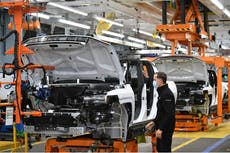Pilot scheme to trial electric vehicles as home generators for California’s rolling blackouts
The first tests involving vehicle-to-home charging will begin later this year in California
A pilot scheme is trialling the use of electric vehicles (EVs) as generators for Californian homes during rolling power blackouts.
Pacific Gas and Electric Company (PG&E) and General Motors (GM) announced a collaboration this week that will test whether an EV with a charger that allows power to flow in two directions can keep a home running, once it has been outfitted with the right tech.
After lab trials, the first tests on EVs capable of vehicle-to-home charging will begin later this year in a small number of California residences, with the aim being a further rollout.
Not only could it be a game-changer for residents attempting to keep the lights on, but the system could also reduce reliance on domestic petrol- or diesel-powered generators, which are costly and can prove fatal if used incorrectly. There is also the possibility that EV owners could receive payments for feeding power back into the grid in times of need.
California has led the US in the uptake of EVs, in part because of progressive state policies aimed at reducing the human-caused carbon emissions that are driving climate change. Transportation accounts for 29 per cent of total US emissions.
In 2020, governor Gavin Newsom signed an executive order stating that by 2035, all new cars and passenger trucks sold in California must be zero-emission vehicles.
California has been on the front line of some of the most extreme effects linked to the climate crisis in recent years.
An unprecedented number of wildfires raged across the state in 2020, with last year being the second worst on record. Much of the state spent 2021 in extreme drought, and heatwaves have become so intense that state legislators are looking to establish the nation’s first ranking system to highlight the risks.
This year is already giving cause for concern over wildfires. While California had heavy rain at times during autumn and winter, the storms were interspersed with extended dry periods. California had its second-driest February on record, the National Oceanic and Atmospheric Administration said this week.
Blackouts have become more frequent in California during the hot and dry summer months. Utility companies intentionally turn off power in areas when it gets too windy and there is a high risk of lightning strikes, in order to prevent toppled power lines from starting wildfires. In 2018, fallen PG&E lines started a wildfire that killed 85 people in the town of Paradise.
California has also suffered blackouts when scorching summer temperatures increase demand beyond the grid’s capacity.
But power blackouts bring their own set of problems. During a major heatwave, cutting power leaves homes without cooling systems, which can be deadly for vulnerable people. It can also cause major problems for businesses, such as grocery stores and restaurants, that rely on refrigeration. More broadly, nearly every business now relies on electricity to digitally process payments and keep in contact with customers.
Having an EV that serves as a back-up power option at home, and perhaps also as a resource for the grid, is a “huge advancement for electric reliability and climate resiliency”, said Patti Poppe, the CEO of PG&E, the US’s largest utility provider.
GM, the country’s biggest auto manufacturer, says that by 2025 it will have produced more than a million EVs in North America.
Join our commenting forum
Join thought-provoking conversations, follow other Independent readers and see their replies
Comments


Bookmark popover
Removed from bookmarks